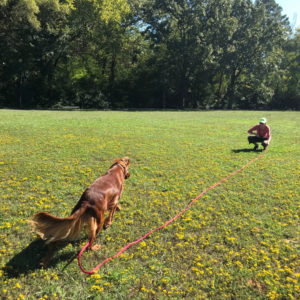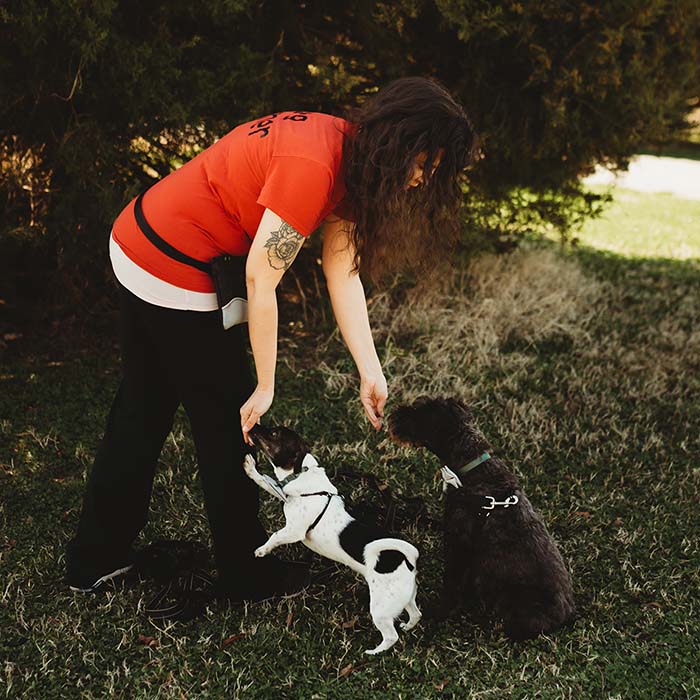Bite risk
What dogs taught me about humans
I couldn’t stop worrying.
I’ve found I have two methods of worry. One is a deep, gut-rooted concern that legitimizes when something actually happens. The other is a shallow fear without any apparent cause.
It was the second option that night when I told the manager that I kept expecting people to be mean to me.
After I left the doggy daycare in March of 2019, I found myself stuck.
It was a difficult lesson, and I started thinking that maybe I shouldn’t even be a dog trainer. Since I needed to pay the bills, I turned to serving as I tried to figure it all out.
Even without experience, I was offered a position at La Terraza Rum and Lounge. After I was there for about four months, I took a break and tried out an office job, which, spoiler alert, was not a good fit for me, and I ended up back in the serving world at Graffiti’s, which is owned by the same folks who manage La Terraza.
I couldn’t stop thinking about dog training.
There’s this magical aspect to it, where I can see dogs get excited and their people’s faces light up when they learn something. And some will say it’s just the food, but it’s more than that. It’s building trust with your dog. It’s establishing communication. It’s moving away from or redirecting challenging behaviors while encouraging manners. There’s nothing quite like it, and I couldn’t quit altogether.
I started Telltail Dog Training that summer and kept the server job on the weekends.
But every night, before every shift as a server, I was worried.
That particular night, I voiced my concern to the manager, and he said, “Whenever you go into a dog training session, do you always expect the dog to bite you?”

Of course not.
It was an eye-opening question, because behavior management simply requires understanding and experience. I am comfortable with dogs because I have spent a lot of time with them and I have an understanding of their behavior and how to manage it. I couldn’t figure out why it was so difficult for me to transfer some of those same skills onto human behavior.
I’m no longer a server, and I’ll be ending my time with Bark Bar in the next few weeks, which, although it was fun and combined my experience of serving AND dogs, was not quite the right fit for me. I’m focusing on training and my writing work instead, and I’m excited for several projects in the wings that I’ll share here and on the podcast and YouTube channel.
In the meantime, here are three things I learned about humans from dog behavior:
- Dogs tend to showcase behaviors that show they are very interested in interacting. This tends to be a loose, open mouth and wiggling body. Sometimes they jump up, and it’s up to us to redirect that behavior. But for the most part, dogs have clear signs that they’d like to interact. People have similar signs as well. They’ll hang around, or make eye contact, or ask questions. And just like dogs, people need some time to warm up or feel comfortable. Before I was a dog trainer, I was a journalist and writer (and I still am), but I’ve been surprised at myself by how often people have been uncomfortable and I never noticed. They tend to calm down in time, but before I started paying attention, I was taking their discomfort in the interview as a sign that they didn’t like me. The two things are often not connected — I’m asking people to share intimate details about their life on camera and on a podcast. It’s nervewracking! But because I’m comfortable doing it, I was overlooking the signs that they weren’t, or I was misreading them.
- And in line with that, expecting every human to be mean or interact with me roughly has been unfair to a lot of humans that I’ve interacted with before I realized this. When I’ve gone into a situation expecting hostility, I actually have encouraged hostility as a self-fulfilling prophecy, because I’m tense and nervous, not making eye contact, or giving short answers. When I’ve instead interacted with people with curiosity, like I do with most dogs, I’ve invited them to show me who they are instead.
- And finally, positive reinforcement goes a long way with people, just as it does with dogs. One thing I’ve been working on is letting people know that what I’ve seen is a good thing. And I never say anything I don’t mean. It has to be genuine. I am not going to say encouraging words without the proper intent behind it, because tone also matters, just like tone matters to a dog. We could say something like, “Well, aren’t you a baked potato” to a dog, which means nothing, but if we say it in a high-pitched voice, it’s very likely that the dog will be excited. And we could say “I love you” in a mean, growly voice, and while the words are nice, the intention and tone aren’t.

And now for the things that dogs don’t enjoy, or where our human tendencies can impact how dogs interact with us:
- Don’t stare at a dog. I’ve had to intercede with several people who have been staring a barking dog down while reaching for it. That’s the fastest way to get bitten. While yes, some dogs bark because they want attention, others are barking because you’ve locked eyes with it and are moving towards it in a way that the dog considers threatening. Don’t do that. Instead, look away or walk away. If a dog wants to say hello to you, he will.
- Pet once and stop. Sometimes dogs can feel trapped by our touch, especially if they’re nervous or scared. Dogs can often seem like they enjoy getting pets while they’re just waiting for you to go away. The best piece of advice I ever got was from another trainer that said pet, then stop. You can even take a step or two away. If they come back to you for more, then they’re enjoying the attention. If they don’t, just leave them alone. It’s not personal. This is closely connected to a handshake for us humans. While we often lock eyes and reach out, both locking eyes and reaching out for a dog can be very intimidating. Instead, stand sideways and let the dog approach you when he is ready.
- And finally, don’t put your face in a dog’s face. We had a dog visiting while I was still working at Philly Unleashed who only ever bit anyone when they put their face in his face. It never happened on the farm, but it had happened three times at his home, and he was otherwise a very nice and friendly dog. That was a big lesson for me in behavior management, but also in understanding that quite a lot of dogs don’t like this. Respect a dog’s space.
What are some of the things you’ve learned about human and dog behaviors? Let me know in the comments or shoot me an email at info@telltaildogtraining.com. Telltail Dog Training offers group classes and private in-home lessons in the Little Rock area, along with training walks for current clients. Find Telltail’s podcast here, or find additional information on Instagram, Facebook and YouTube.



